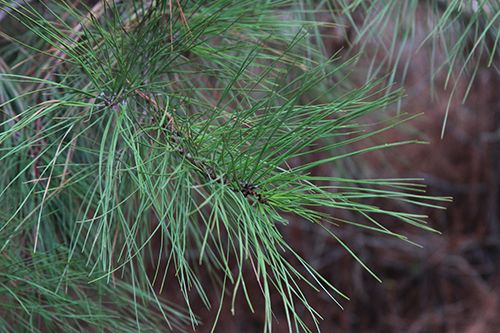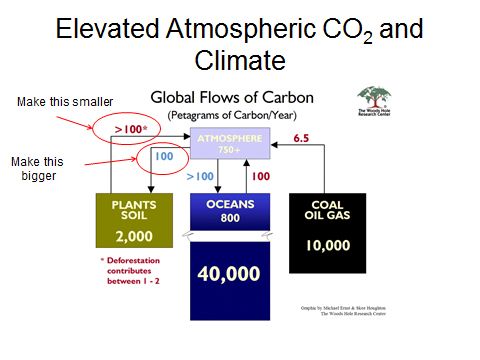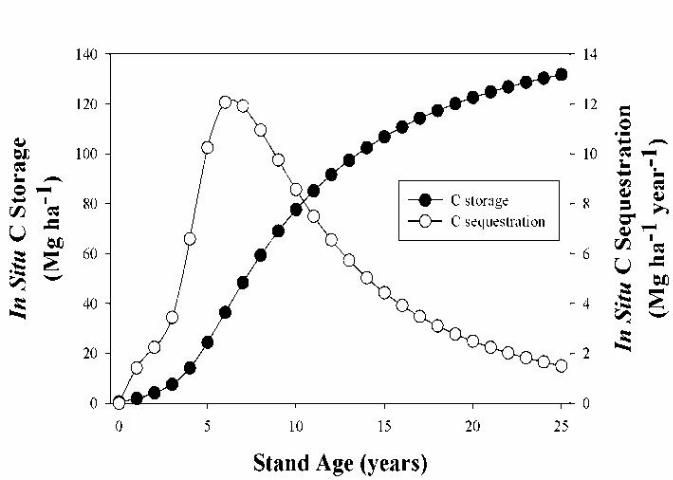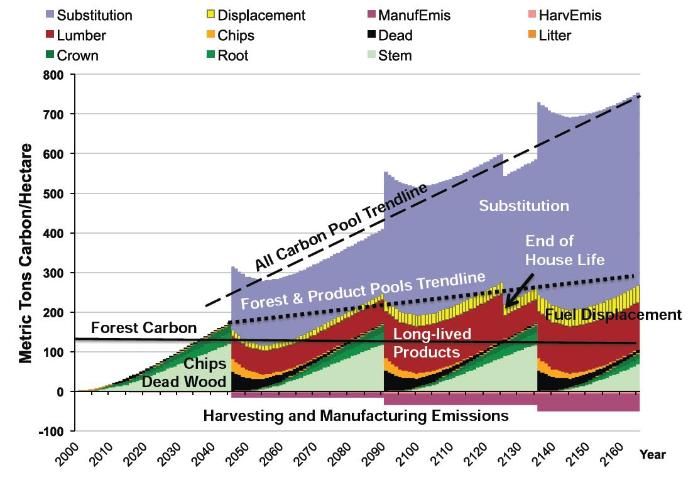Trees store carbon as they grow and produce wood. Just like all plants, trees use photosynthesis to remove carbon dioxide (CO2) from the air and turn it into sugars, and then use the energy stored in sugars to live and grow. Trees and other woody plants also have the distinct advantage of being able to store that carbon in the form of cellulose—as wood. Carbon, and carbon storage in particular, have become important topics as policymakers, scientists, and industry leaders consider how to address the increasing amount of CO2 in our atmosphere. Because it changes the composition of the atmosphere, CO2 is a leading contributor to climate change. Storing carbon in living trees and in long-lasting wood products such as lumber and furniture is one way to reduce atmospheric CO2. This is a particularly important consideration in Florida, where forests take up and store millions of tons of carbon each year. These forests cover almost 17 million acres in Florida alone, and 64% of them are owned by families, individuals, investment firms, and timber industries (Brenner et al. 2014). Florida's forest and wood-product industries are worth billions of dollars. Clean water, wildlife, and other benefits add to the value and importance of these forests.

Credit: Adam O. Maggard, Auburn University School of Forestry and Wildlife Sciences
The Carbon Challenge
Carbon dioxide cycles among carbon "sinks," such as plants, soil, and the ocean, that store carbon. These sinks absorb carbon as part of the natural carbon cycle (Figure 1). Each of these sinks also releases it to the atmosphere in amounts that vary with the situation. While the amounts of carbon flowing between the surface ocean and the atmosphere and among plants, soil and the atmosphere are more or less equal, burning fossil fuels for electricity, transportation, and industrial uses adds fossilized carbon to the system. This is one reason that atmospheric CO2 levels have increased from approximately 280 parts per million (ppm) in 1800 to over 400 ppm today (Scripps Institution of Oceanography 2016). At the same time, changes in land use, such as fewer forested acres and more developed land, have additionally reduced the capacity of our landscape to sequester, or take in, carbon. Both factors have resulted in more carbon in the atmosphere than can be removed by plants and the ocean. This imbalance in the carbon cycle is one cause of increases in global surface temperature, ocean acidification, and a more variable climate. Scientists are exploring strategies to increase the natural carbon storage potential of soil, for example, as well as seeking new strategies for removing carbon from the atmosphere.
Forests (including vegetation, soils, and harvested wood) are a still a critical element of the carbon puzzle since they currently offset annual greenhouse gas emissions produced in the United States by approximately 13%. This makes forests very important for helping to reduce global CO2 levels (US EPA 2011). Replanting forests more quickly, converting more land to forests, and keeping trees growing longer are three ways forests can sequester more carbon. Figure 1 suggests that increasing carbon moving to forests by planting more trees will help reduce atmospheric carbon.

Credit: The Woods Hole Research Center
How Forests Store Carbon
Forests soak up carbon dioxide through photosynthesis in tree needles and leaves—a process where energy from the sun is used to turn carbon dioxide and water into sugars. These sugars are used for energy as "food" for plants and are also used as building blocks for tree growth. As they use these sugars they also release some carbon back to the atmosphere.
Trees sequester carbon as long as they are actively growing and storing more carbon than they release. As trees mature, they sequester less carbon but gain the capacity to store carbon (Figure 2). Once a tree dies, decomposition releases some stored carbon back into the atmosphere, while some carbon remains in woody tissues and ultimately ends up in the soil. Soil microbes convert fallen needles, leaves, and decomposing wood into soil carbon and atmospheric carbon. If trees are harvested, the carbon can be stored in wood products such as lumber, furniture, pallets and other construction materials. When wood is burned for energy, such as in cogeneration or woody biomass facilities, and trees are replanted, the carbon released by burning the wood for energy moves to the atmosphere where it is available for growing trees to absorb. This is called carbon neutrality. Carbon can be stored in trees, soil, and long-lasting wood products, such as furniture and homes, for hundreds of years.

Credit: Carlos Gonzales, University of Florida
The Southern Pine Carbon Story: Grow More Wood, Store Carbon Faster
Private forest landowners are important players in Florida forests. Often, landowners choose to plant pine trees for financial benefit, to benefit wildlife, and for aesthetic reasons. New varieties of pine are disease resistant and fast-growing, enabling landowners to harvest high-quality trees for pulp or timber in 20 to 25 years. Because tree breeders are very familiar with pine tree genetic variation, they will have the ability to breed trees in the future that thrive in a changing climate. In the past five decades, landowners have seen marked improvements in tree growth through better forest management, such as planting improved genetics and other silvicultural techniques (Fox, Jokela, and Allen 2007) and intensified management (Jokela, Dougherty, and Martin 2007), which has increased carbon storage.
New projections for Florida's future climate suggest that with increased atmospheric carbon dioxide and average rainfall, Florida's pine forests should grow faster, yielding more wood per year than before (Thomas and Ahlswede 2015). This benefit of climate change to landowners assumes that other factors, such as water and nutrient availability, do not limit tree growth, and events such as wildfire and pine beetle outbreaks do not counteract the positive effects of elevated atmospheric CO2.
Storing Carbon and Harvesting Trees
It may seem like a riddle, but both planting and harvesting pine trees can reduce atmospheric carbon and mitigate climate change. Once carbon is stored in wood, it continues to be stored in wood after the tree is harvested and converted into wood products, such as studs for a house. Using wood in long-lived products can reduce atmospheric carbon in three ways. The first reduction occurs because the tree itself stores carbon instead of releasing it to the atmosphere, and each replanting means more trees are storing carbon. The second reduction is the long-term storage of carbon in wood products; that carbon is not going back to the atmosphere until the wood rots or is burned. Finally, if the timber products reduce the need for concrete, steel, or plastic products that generate more carbon emissions through their production processes than the wood product, there will be less atmospheric carbon to contend with (see Figure 3). Researchers in the Pacific Northwest have determined that these three carbon pools (the forest, long-lived wood products, and wood substitution) can significantly reduce atmospheric carbon dioxide (Figure 3; Lippke et al. 2010).

Credit: Modified from Lippke et al. (2010)
Landowners already make substantial efforts to store carbon in their trees through sustainable management. With fluctuating pulp and timber prices, landowners may choose to maintain their trees for longer rotations—essentially storing more carbon on the stump to be used as solid wood products into the future. Should policy changes favor a market for carbon in forests, there may be additional financial opportunities to be compensated for that carbon (Soto, Escobedo, and Adams 2014). Currently voluntary markets exist but are only cost effective for the largest properties willing to be qualified and become "certified" as sustainably managed forests, typically requiring longer rotations and a long-term contract. Until such time, landowners engaged in long-term management of their southern pine forests can still benefit from the many other economic and non-economic benefits already derived from our forests.
Summary
Trees naturally store carbon. Southern pine plantations account for approximately 33% or one-third of the nation's annual carbon stored in all of the United States' forests (Jose 2007). Florida's pine plantations represent a partial solution to climate change by storing atmospheric CO2 through enhanced tree growth and wood products. Florida's forest landowners can play a significant role in helping regulate or minimize climate change impacts through carbon storage. Good forest management practices provide landowners with healthy and resilient forests that are better prepared for future climate change.
Literature Cited
Brenner, A., M. Yoders, J. Cothurn, M. Milligan, and B. Condon. 2014. "Comprehensive Statewide Forest Inventory Analysis and Study." Prepared for Florida Forest Service. Available at http://freshfromflorida.s3.amazonaws.com/Media%2FFiles%2FFlorida-Forest-Service-Files%2FForest-Inventory-2015%2FCFIAS+2014+Exec+report+v6.pdf
Fox, T. R., E. J. Jokela, and H. L. Allen. 2007. "The development of pine plantation silviculture in the southern United States." Journal of Forestry 105:337–347.
Jokela, E. J., P. M. Dougherty, and T. A. Martin. 2004. "Production dynamics of intensively managed loblolly pine stands in the southern United States: A synthesis of seven longterm experiments." Forest Ecology and Management 192:117–130.
Jose, S. 2007. "Carbon sequestration and intensive silviculture: The southern U.S. experience." Paper presented at the American Geophysical Union fall meeting. San Francisco, California, December 10–14 (abstract #B53A-03).
Lippke B., J. Wilson, J. Meil, and A. M. Taylor. 2010. "Characterizing the importance of carbon stored in wood products." Wood and Fiber Science, 42 CORRIM Special Issue: 5–14. Retrieved from https://corrim.org/wp-content/uploads/2017/12/Characterizing_the_Importance_of_Carbon_Stored_in_Wood_Products.pdf. Accessed January 19, 2023.
Scripps Institution of Oceanography. 2016. The Keeling Curve. University of California San Diego. Retrieved from https://keelingcurve.ucsd.edu
Soto, J. R., F. J. Escobedo, and D. C. Adams. 2014. An overview of carbon markets for Florida forest landowners. FOR319. Gainesville: University of Florida Institute of Food and Agricultural Sciences. https://doi.org/10.32473/edis-fr387-2014
Thomas, R. Q, and B. Ahlswede. 2015. Regional carbon cycle predications using the community land model. PINEMAP Year 4 Annual Report, page 20–21. http://www.pinemap.org/reports
US EPA (Environmental Protection Agency). 2011. Inventory of U.S. greenhouse gas emissions and sinks: 1990–2009, Executive Summary. Washington, DC. Online at: https://www.epa.gov/ghgemissions/inventory-us-greenhouse-gas-emissions-and-sinks